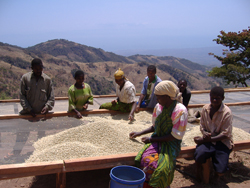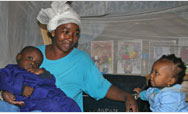You are here » Home » Telling Our Story
Success Story
New technology improves coffee bean quality and frees up time
Better Coffee, Better Lifestyle

| |
Photo: TechnoServe/Felix Mkondo
|
|
Women sort out coffee beans after drying at the community central pulpery unit location in southern Tanzania’s Nyoni village.
“The freed time helps me to spend more time in caring for essential food crops and livestock at home,” said Blanka Ndunguru, a mother of three from Nyoni village in Tanzania’s Southern Highlands.
|
Coffee aficionados know that every step in a coffee bean’s life has to go perfectly to produce a truly spectacular brew. A bean’s quality can suffer as a result of poor harvesting, mishandled fermentation or pulping, or even improper drying.
In Tanzania, the critical work of drying is traditionally done by women. Typically, the beans stay on drying beds for 14 days, during which they require nearly constant monitoring before packaging. Women protect the beans from the hot midday sun, damp nights, and even theft. As a result, women become virtually house-bound.
As part of an overall effort to modernize rural coffee production, USAID is working with small-scale coffee farmers to introduce them to improved coffee processing technology. One element of this program involves creating better drying conditions. Under the program, beans are dried on elevated tables in a central coffee processing facility, where conditions are easier to control, the beans dry faster, and everyone shares responsibility for guarding the beans. As a result, women have more time to tend to other chores.
The drying technique and facilities are part of a coffee processing technology, known as a central pulpery unit, that is improving quality along every step of the way. USAID has been introducing rural communities to these machines, which process coffee beans efficiently and consistently with regulated pulping and fermentation. Once coffee-growing communities see how the machine works, they are eager to pool resources to buy one. After they purchase a machine, it is placed in a central location, where all coffee harvesters use it. Communities equipped with these machines have moved coffee processing from individual homes to a central facility with soaking tanks for washing, elevated tables for more consistent drying, and a storage and packing area.
Blanka Ndunguru, a mother of three from Nyoni village in Tanzania’s Southern Highlands, is pleased with this new technology. “Apart from assuring coffee quality and simplifying our work, the freed time helps me to spend more time in caring for essential food crops and livestock at home,” she said.
Print-friendly version of this page (421kb - PDF)
Click here for high-res photo
Back to Top ^ | 

